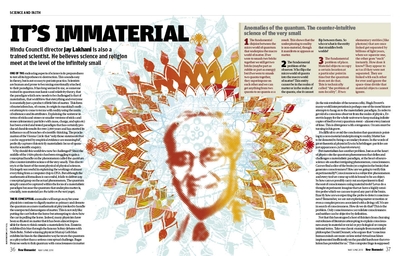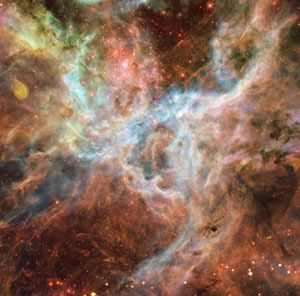 In our May/June issue, Jay Lakhani, director of the Hindu Council, argued that quantum physics helps to reinforce his belief in esoteric Hinduism. We asked physicist Mano Singham to respond.
In our May/June issue, Jay Lakhani, director of the Hindu Council, argued that quantum physics helps to reinforce his belief in esoteric Hinduism. We asked physicist Mano Singham to respond.
Despite his claim to have been trained in quantum mechanics and relativity theory Jay Lakhani’s suggestion that esoteric Hinduism is confirmed by quantum physics, and that it proves “materialism” false, is wrong on so many levels that one scarcely knows where to begin.
The idea that quantum physics can be used to destroy materialism is absurd because it is an entirely materialistic theory that does not postulate any distinct non-material entities (such as the mythical “quantum”) but says that all elementary particles of matter (electrons, photons, neutrinos, quarks, etc.) behave in a completely law-like manner. Indeed it is this fact that enables the theory to be so extraordinarily successful and precise
Lakhani has a strange idea that “the quantum” is not a material entity and is more fundamental than matter. But “the quantum” is not a different kind of entity from matter, but a description of the properties of matter. For example, the energy in a light beam is not distributed continuously but comes in discrete packets (or quanta) called photons. The angular momentum of an electron cannot have any value but is quantized to have discrete values. And so on. There is no such thing as “the quantum” existing independently of matter, which makes nonsensical Lakhani’s claim that there is a “micro world of quanta” and a “macro world of matter”. Let’s examine his list of three “anomalies” that purportedly make his case.
In the first item he states, “If we were to smash two quanta together, they superimpose on each other and we can get anything from two quanta to no quanta as a result.” This is meaningless because, again, there are no such things as generic quanta. One can talk of smashing two particles such as electrons together and what one gets depends on the energies of the colliding particles and can be predicted accurately using the laws of quantum mechanics. But it is never the case that two colliding electrons would result in nothing.
For his second item, he takes a genuine difficulty of quantum theory, that the “observer” in physics (i.e., the macroscopic measuring apparatus) obeys classical laws while the elementary particles it measures obey quantum laws. This problem is erroneously used to prop up his idea that the quantum is some kind of independently existing non-material entity.
His third item uses the well-known result that it is possible for two particles to be separated by a large distance and still have correlated behaviour, so that if one particle is disturbed the other’s state will be affected instantaneously. This phenomenon has been tested and supported by experiment. But it is not true that the two particles “are linked with each other for ever and ignore the space-time divide that material objects cannot ignore.” If the correlated state is disturbed, coherence is lost and the two particles henceforth act independently. Most importantly, this type of non-locality is consistent with the laws of quantum mechanics and is not a violation of the laws of physics.
Just because the microscopic world governed by the laws of quantum mechanics has some counter-intuitive features does not provide a license for people to insert mystical ideas in order to satisfy their metaphysical desires.

